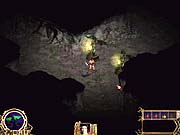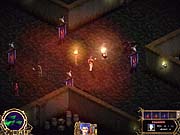Nightstone Preview
We take a look at the upcoming isometric RPG from New Horizon Studios.

There really isn't an easier way to create a solid game than using a successful preexisting recipe--especially if that recipe comes from one of the most popular RPG franchises ever created. Virgin Interactive's upcoming isometric 2D RPG, Nightstone, does exactly that, as it attempts to mimic most of Diablo's features, including the battle system, portions of the inventory system, and other aspects of gameplay. Nightstone also includes a number of interesting features, one of which is a largely nonlinear single-player mode in which three different characters can be controlled and led on three different paths. The game also includes a stealth element that becomes valuable during confrontations with larger groups of enemies.

There are three characters in the single-player mode of Nightstone. They all have different skills and a different storyline, but they ultimately have the same quest. The first character of the group is Terak, a barbarian who's been having dreams of an old ancestor--a sign that the ancestor had a duty that was never fulfilled. Terak sets out on his journey to find out what happened to his ancestor and whether or not he can do anything about it. As you might expect, Terak is the best melee fighter out of the three characters because of his proficiency with a sword, but what makes him valuable as a tanklike character is that you can control his ability to block enemy attacks with his shield. His only substantial weakness is his inability to use stealth in an effective manner.
The next character, and the most balanced of the three, is Rhelia, the archer. Since she was born in the forest among a solitary group of people, Rhelia's been taught to respect the forest and the creatures that dwell in it. But she's also learned to be distrustful of outsiders, since they're largely responsible for the widespread destruction of the forests in the gameworld. Eventually, Rhelia leaves her people to confront the being responsible for destroying most of the world's forests. Since she uses a bow and arrow as her primary weapon, Rhelia can stay back and deal with individual enemies at long range rather than engage a horde of enemies at once. If you happen to get caught in the pack using Rhelia, it can be difficult to escape to a safe distance where you can start attacking enemies again. Fortunately, she can withstand more than a few direct hits.
The last of the three characters is the magic user, Aisat. Aisat was born not knowing who her parents are or where she came from. Eventually, she was taught to use her magic powers by the same man who took her in and raised her. As she started to grow more powerful, her mentor became concerned and told Aisat that a stain must be removed from her soul. Aisat has the most powerful long-range attacks, and she has access to all the spells in the game. Of course, she's quite weak when it comes to withstanding attacks, and unlike Rhelia, if she gets caught in a group of enemies, she's not likely to survive.
The Art of Surprise

After learning about the characters, you'll have a chance to distribute points to their four basic skills: strength, resistance, skill, and power. Strength simply refers to the amount of damage your character deals out with each strike. Resistance increases your hit points, as well as your stamina, which can be used for running. Putting points in skill improves your character's stealth ability, and power increases mana levels. Since each character has a different method of attack, it's wise to distribute points in a way that enhances his or her skills. For Terak, strength is probably the most important attribute, but for Rhelia, skill may be the most valuable attribute because it increases her ability to sneak up on enemies. There doesn't appear to be much more than that in terms of character building, which might disappoint fans who prefer RPGs with more malleable characters.

When you're done with the initial configuration of the characters, Nightstone brings you into a map screen with three figurines placed at three points across the map. These three figurines represent the three characters in the game, and they can be moved to any territory adjoining their current position. For example, because of their starting positions, Terak and Aisat can only move in one direction to another territory, while Rhelia can move in two directions into two different territories. When Terak and Aisat move out of the peninsula areas--done by completing a series of levels--they too can move in multiple directions and eventually join forces to form a three-member party.
Nightstone's interface is largely similar to Diablo's. Everything from the battle system, which is just basic point and click, to the types of items is basically the same. The inventory also functions the same basic way, though it separates heavy items (rings, weapons, and armor) from lighter items (potions and scrolls). There's also a smaller belt inventory system for quick access to healing or mana potions. Next to the character portrait, there are three bars that represent health, mana, and stamina, and there are a few quick links to level objectives and other options in the lower left corner. It certainly seems as though the development team made a concerted effort to make the inventory and character status screens as unobtrusive as possible.
If Nightstone has any notable features that keep it from being a clone, it's the stealth and line of sight aspects. In the lower left part of the screen, you'll see a map that gives you the position of nearby enemies and depicts their field of vision, similar to the onscreen map found in games like Metal Gear Solid. If you happen to run into the triangle area that represents an enemy's field of vision, then you'll attract the attention of that particular enemy, but if you manage to sneak up on him or her, then you'll get in a few shots before he or she can even turn around. Obviously, this tactic is more suitable for Rhelia and Aisat because of their long-range attack skills, though Terak doesn't really need to use stealth as much anyway, as he can withstand a very brutal assault.
Nightstone is a straightforward RPG that's geared more toward fans of Diablo and casual fans of the genre as opposed to the Dungeons & Dragons crowd. The current build has a few impressive features, including support for 1024x768 resolution, as well as a nonlinear single-player campaign and a multiplayer mode. Nightstone is scheduled for release later this year.
Got a news tip or want to contact us directly? Email news@gamespot.com
Join the conversation